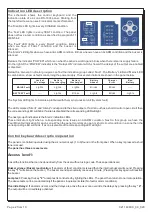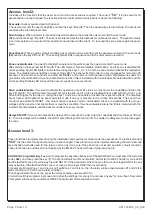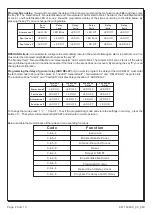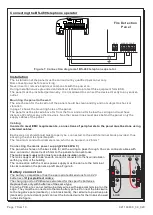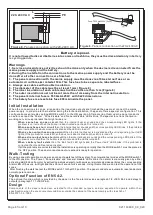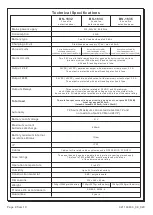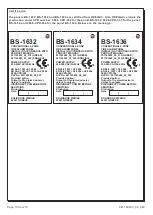
Battery disposal .
I
s not allowed to discard batteries into common trash bins, they must be discarded only
Warnings
.
1.
Service and maintence activities should be done only when the device is disconneted from the
mains power supply and the battery.
2. During the installation the connections to the mains power supply and the battery must be
done after all other connections are finished.
3. The panel connection with the mains supply must be done via a10A external fuse or an
automatic circuit breaker rated at 10A.
This fuse has to be a separate, labeled fuse.
4. Always use cables with double insulation.
5. The diameter of the cable must be at least 1mm.(
F
igure 9)
6. The inner insulation of each cable must not be cut more than 1cm (
F
igure 9)
7. The outer insulation must not be cut more than 1cm away from the internal insulation.
8. The panel's internal fuse is T630mAL250V with 5x20 dimensions.
9. The batery fuse is a resetable fuse
900m
A inside the panel.
When the connections to zones, sirens and other required outputs are finished then we must connect the mains
power supply. In order to aid the installer during the initial installation, the panel offers a special configuration. This
configuration is entered by setting MODE switch 1 to the ON position. After entering this mode the panel conducts
an auto reset and the 'Power', 'Zone disable' and 'General disable' LEDs blink. The special functions that aid in
working out various problems that might arise are:
If all the problems are corrected and the installation is operating normally then the MODE switch 1 must be placed in
the OFF position. The panel conducts a
n
auto-reset and is ready for operation.
By using a special operation mode we can conduct a walk test of the system. To enter walk-test mode set the MODE switch 1
to the ON position. The 'Power', 'Zone disable' and 'General disable' LEDs blink. If an alarm is manually given by either
activating a BS-536 call point or by activating a smoke detector with smoke or simulated smoke particles the corresponding
Alarm LED of the zone will light and the siren will sound for 2 seconds. Using this method we can test the operation of the
zones.
After finishing the walk test set the MODE switch 1 to the OFF position. The panel conducts an automatic reset and enters
normal operation mode.
The optional function which is provided by the panel is the fire alarm devices paragraph 7.8 of
EN
54-2
and delays to
outputs (paragraph 7.11 of EN 54-2)
.
t i
in battery
recycling points.
Initial Installation
When a zone has an open circuit
then the internal buzzer sounds and the corresponding LED lights. If the
problem is corrected then the buzzer is deactivated and the LED is
turned off
.
When a zone has a short circuit
then the internal buzzer sounds and the corresponding LED blinks. If the problem
is corrected then the buzzer is deactivated and the LED is
turned off
.
When a siren output has an open circuit
then the internal buzzer is activated and the corresponding fault LED
lights. If the problem is corrected then the buzzer is deactivated and the LED is
turned off
.
When a siren output has a short circuit
then the internal buzzer sounds and the corresponding LED blinks. If the
problem is corrected then the buzzer is deactivated and the LED
is
turned off
.
When a battery fault exists
then the 'Batt fault' LED lights and the 'Power fault' LED blinks. If the problem is
corrected then the LEDs are deactivated.
Walk - Testing
Optional Function of EN 54-2.
Design
Components of the panels have been selected for the intended purpose, and are expected to operate within their
specification when the environmental conditions outside the cabinet of the panel comply with class 3k5 of
EN 60721-3-3:1995.
Figure 8.
Panels connection with
220-240V
AC
.
220-240V AC
L
N
1 cm
Fuse: T630mAL250V (5x20)
1 cm
Figure 9.
Panels connection with
220-240V
AC
PE
Page 8 from
10
921163600_09_020


